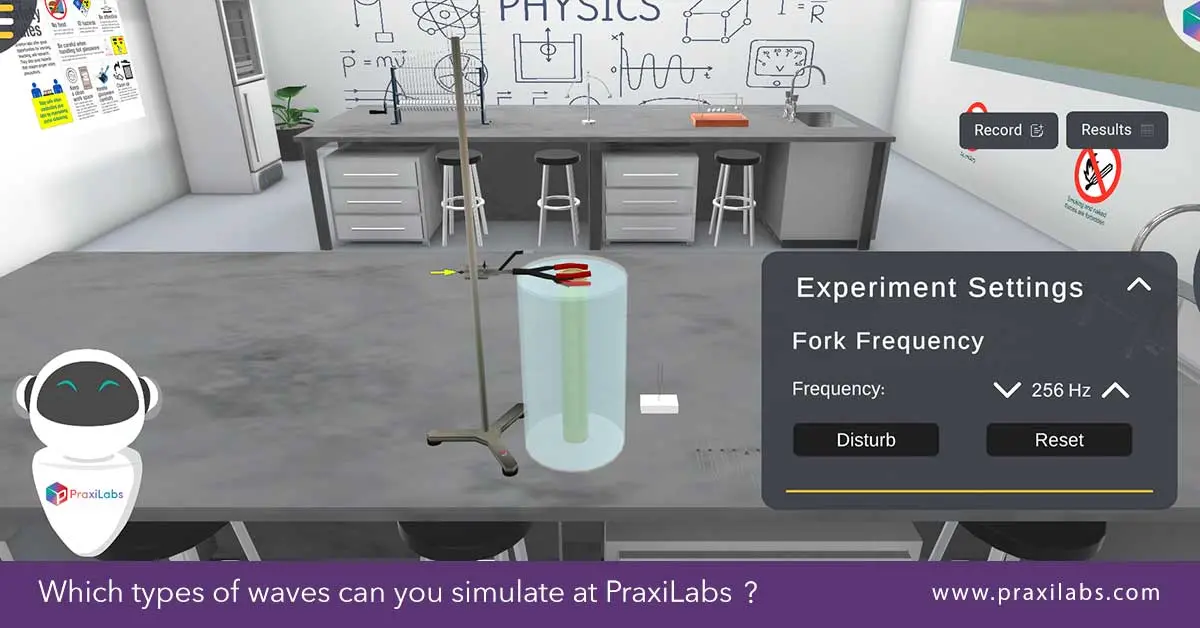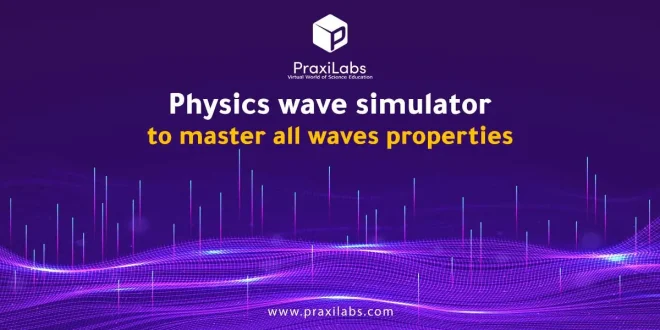Last Updated on August 3, 2025 by Muhamed Elmesery
Just imagine that you can make wave behavior visible and your students can see wave interference, reflection, and other related phenomena! By using a physics wave simulator, you can easily do this and more!
In this blog post, we will discover what is a physics wave simulator is, why to use one?, the learning goals of using wave simulators in education, how useful they are for students, and which types of waves you can simulate using PraxiLabs.
Table of Contents
What is a physics wave simulator?
A physics wave simulator is a computer-based simulation created to mimic and visualize wave behavior.
These 3D simulations allow students to explore and understand how different types of waves (like light, sound, or water waves) behave under various conditions and parameters.

Why to use a physics wave simulator 3D?
Using an online wave simulator provides several features for both students and educational institutions, Here’s why it’s valuable:
1. Visualize Invisible Concepts
By using physics virtual labs, waves (especially sound or light) can be abstract.
Simulators make wave behavior visible — like interference and reflection which helps students understand more deeply.
2. Safe and Cost-Effective
There is no need for expensive real lab equipment, your students can perform their experiments using their devices.
No risk of hazards (e.g., electrical, thermal, and laser hazards).
3. Interactive Learning
Students learn in an immersive and interactive environment. They can change variables like frequency and instantly see the result.
Using virtual labs enhances critical thinking skills and active learning, not just passive observation.
4. Repeatable and Instant Feedback
Simulations can be repeated endlessly anytime, and anywhere to sharpen understanding and make students better prepared to deal with real laboratories.
Immediate feedback helps correct misconceptions immediately..
5. Supports Remote or Blended Learning
Virtual lab simulations are Ideal for online education or distance learning.
Students can access labs anytime, anywhere from their devices.
6. Prepares for Real Experiments
Helps students understand the theory well before using real physics lab tools.
PraxiLabs provides instant and unlimited access to several physics simulations you need from anywhere, without the hassle of going to the laboratory from our Physics simulation app or platform. Let your young scientists enjoy their journey, anytime!
Learning goals of using wave simulators in education
- Understanding and visualizing wave behavior, especially with phenomena observed in real life.
- Learning the law of waves by studying the behavior of a mass on a spring.
- Gaining understanding of several concepts, such as how to differentiate between both the focal length and power of a lens, and how to determine them.
- Setting up experiments to determine wave behavior under several conditions (ex: the speed of sound in air using an open air column or Closed Columns).
- Exploring wave properties like frequency, and wavelength, and how they relate to each other.
Do wave simulators have any limitations?
Wave simulators, like any simulation, have limitations. These can include:
- Computational constraints.
- Simplifying assumptions.
- The inability to perfectly replicate real-world conditions.
- Some simulators may have limitations in terms of the types of waves they can accurately or the specific parameters they can simulate.
How much is wave simulator Useful for Students?
A study aimed to investigate the effectiveness of utilizing a self-made wave machine and a computer simulator in teaching basic concepts of waves to Grade 7 students explored how these hands-on and technology-based approaches impact student performance and interest in science education.
By allowing students to see and manipulate wave properties dynamically, these tools offer interactive and visual experiences that make abstract concepts more concrete and understandable.
The hands-on engagement with wave properties, including amplitude, frequency, and wavelength, not only aids in visualization but also deepens comprehension.
Furthermore, this interactive learning typically results in:
- Higher engagement levels.
- Improved learning outcomes.
- A deeper understanding of the material.
By making science more accessible and enjoyable, these tools enhance immediate learning outcomes and inspire sustained interest and confidence in pursuing further studies and careers in scientific fields.

Which types of waves can you simulate at PraxiLabs?
PraxiLabs, as one of the best online platforms for physics wave simulation online, offers a variety of physics experiments for educational purposes, including simulations of real-world scenarios and investigations into fundamental physics concepts.
Let’s discover some simulations and identify the type of wave they involve:
| Simulation | Wave Type | Explanation |
| Focal length convex lens simulation using general law | Light Waves (Electromagnetic) | Light rays bend (refract) through the lens — part of electromagnetic wave behavior. |
| Simple Pendulum | Mechanical Oscillation (not a wave itself) | It involves periodic motion, not a traveling wave — but it models harmonic motion, which is foundational to wave physics. |
| Hooke’s law simulation | Mechanical Oscillation (not a wave itself) | Like the pendulum, it describes simple harmonic motion — essential to understanding mechanical waves. |
| Speed of Sound Using Closed Columns | Sound Waves (Mechanical, Longitudinal) | Simulates resonance of sound waves in closed air columns — a classic longitudinal wave example. |
| Speed of Sound Using Open Columns | Sound Waves (Mechanical, Longitudinal) | Similar to the closed column, but with open ends — another example of sound wave resonance. |
| Simple harmonic oscillator simulation | Mechanical Oscillations → Resonance Waves | When a system is driven at its natural frequency, standing waves can occur — this simulates resonant behavior typical in wave systems. |
Try PraxiLabs and Experience a Virtual World of Science Education
Pick the Best Virtual Plan or You
Top FAQs about wave simulator
How can I implement a scientific simulation in physics?
You can implement a scientific simulation in physics by using interactive methods such as 3D online physics simulations that enable you to conduct physics experiments and understand several concepts through virtual labs anytime, anywhere, and as many times as needed.
Do virtual labs simulate waves accurately?
Yes, by using virtual physics lab you can simulate waves with a high degree of accuracy, offering a valuable learning tool for understanding wave phenomena. While they may not perfectly replicate all aspects of real-world experiments, they excel at visualizing complex concepts and providing a controlled environment for experimentation.
Now is your educational institution’s moment to power up your students’ inner scientists and open up a world of possibilities!
 PraxiLabs A virtual world of science
PraxiLabs A virtual world of science






